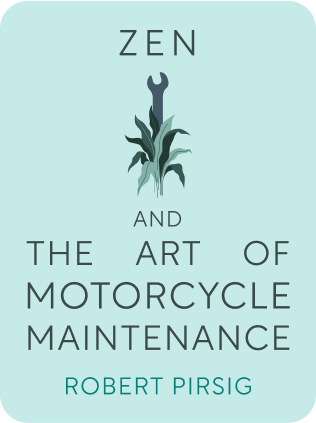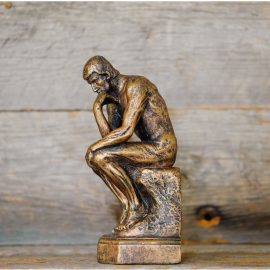

This article is an excerpt from the Shortform book guide to "Zen And The Art Of Motorcycle Maintenance" by Robert Pirsig. Shortform has the world's best summaries and analyses of books you should be reading.
Like this article? Sign up for a free trial here .
What is the difference between science vs art? What does Robert Pirsig say about these differences in his book Zen and the Art of Motorcycle Maintenance?
In Zen and the Art of Motorcycle Maintenance, author Robert Pirsig explains the two life philosophies in science vs art. He conveys these through his ideas, and through the differing ideas of fellow travelers.
Read more about the difference between science vs art in Zen and the Art of Motorcycle Maintenance.
Science vs Art
The next morning, Pirsig is up before the rest of the group. To kill time, he decides to tell us what to pack for a motorcycle trip across the Dakotas. He divides the list into four categories: clothing, personal stuff, camping equipment, and motorcycle stuff.
Along with the essentials for any long-distance riding trip—durable gloves, rain gear, and spare parts—Pirsig also brings books. On this trip, he’s brought three: his cycle’s shop manual, Chilton’s Motorcycle Troubleshooting Guide, and Thoreau’s Walden.
He’s brought Walden for Chris’s benefit. He errs on the side of too-sophisticated when he considers books to share with Chris, because then the book becomes a spur to conversation. He’ll read a sentence, Chris’ll ask a series of questions, then he’ll read another sentence. They can pass a whole evening reading and talking in this way.
Pirsig also notes that he hasn’t brought shoelaces.
At last Pirsig decides to rouse the group. They pack up and hit the road toward Ellendale, where they’ll have breakfast. It’s cold out, but the scenery is beautiful: dawn light, sparkling dew and mist in the fields. Pirsig looks fondly at his old gloves, which are frosty from the cold.
Chautauqua: Love Your Stuff
Even though he bought his gloves for a measly three dollars, Pirsig has had them repaired so many times they’re nearly disintegrating. This is because they are bound up with Pirsig’s memories, good and bad, of traveling; they have a memory of their own.
Pirsig feels the same way about his motorcycle. Even though it’s getting long in the tooth—27,000 miles on the odometer makes it a well-used cycle—he has a certain affinity for it. It has a personality, which is the product of what Pirsig knows and feels about it.
Developing a motorcycle’s personality is the point of motorcycle maintenance. New motorcycles, though nice-looking, appear to their riders as strangers, and they can quickly turn nasty if poorly cared for. A cycle that is attended to—loved—on the other hand, can turn into a lifelong friend. Even though Pirsig’s motorcycle was nearly ruined by the spectator mechanics, it has recovered and bothers Pirsig less and less as time goes on.
The travelers reach Ellendale and dismount their cycles. When Pirsig tries to engage in some banter with the Sutherlands about the cold ride, they give him the silent treatment. Finally, once breakfast is over, John speaks. He says they’re not going anywhere until it warms up. While John, Sylvia, and Chris take shelter in a hotel lobby next door to the restaurant, Pirsig takes a walk. Discovering a quaint but uneventful town, Pirsig returns to the restaurant parking lot and sits on a bench beside his cycle.
Chautauqua: The Sutherlands and Technology II and Talking about Science vs Art
If the Sutherlands can’t handle physical discomfort, and they also can’t stand technology, where does that leave them? They condemn technology even as they depend on it—it’s the dependence that irks them.
A trio of farmers, breezing into town in a brand-new pickup, illustrates the irony. As Pirsig watches them, he opines that those farmers would know how to fix that pickup (among a host of other machines) if it broke down. The farmers value and understand technology—this, despite the fact that they depend on it far less than the Sutherlands (or Pirsig, for that matter). If all technology ceased to function, the farmers could get by, whereas Pirsig and the Sutherlands would perish in no time. The Sutherlands, Pirsig decides, are ungrateful for technology, and are unhelpful in the conversation about science vs art.
The temperature has risen a bit, so Pirsig enters the hotel. He finds his compatriots in an empty dining room, their spirits a bit higher. John reports that he’s going to put on as many layers as he can before hitting the road, and some hilarity ensues when he bounces around the dining room in his long underwear.
On the highway again, Pirsig finds the weather is much more pleasant. The surroundings are still magnificent. When they stop for a breather, John takes out his camera to photograph the prairie around them. Soon enough he gives up—he realizes that it’s impossible to recreate the experience of that environment through a lens. Pirsig notes that seeing the world through a camera is like watching it go by through a car window (see Chautauqua: Motorcycle > Car in Chapter 1). Chris lets it be known that he wants to camp out that night, and after some hesitation, Pirsig relents. But they still have more riding to do before they stop for the day.
A change in the topography—the flatness of the prairie gives way to hills—tells Pirsig they’re nearing the High Plains. The dilapidation of the towns in which they stop and the rolling hills lets Pirsig know they’re officially in the West. Sweeping up and down the grades, Pirsig realizes that if his cycle breaks down now he’s in big trouble—there isn’t a mechanic for miles. Reflexively he checks the engine temperature; it’s fine. There’s a rattling sound, but he knows that’s normal for his cycle.
Chautauqua: Underlying Scientific Explanation vs. Immediate Artistic Appearance
Reflecting on the “nickels-and-dimes” sound of his engine, Pirsig recalls that he once tried to interest John in that sound to no avail. John simply refuses to think about anything mechanical, a telling part of his conversation regarding science vs art.
Pirsig thinks of another example of John’s stubbornness. When John’s handlebars were slipping some time ago, Pirsig diagnosed the problem and suggested John use a particular tool—a shim (Shortform note: a thin piece of metal that helps align or reduce wear on parts). John asked where he could buy one, and Pirsig held up his beer can: the aluminum in the can was perfect for the job John needed done. But instead of seeing the cleverness or resourcefulness of Pirsig’s solution, John was offended. How dare Pirsig suggest fixing an expensive BMW motorcycle with a beer can!
After some further rumination, Pirsig realizes that John wasn’t just being snobbish. Rather, his and John’s differing views of the beer-can solution say something profound about their respective visions of reality:
Pirsig is a rationalist, a scientist, whose view of the beer can was informed by his knowledge of the can’s material properties. He was concerned with what the shim meant—its underlying form, its potential to solve problems—and so had no objection to using a beer can as a substitute as long as it worked. His vision of reality is informed by underlying scientific explanation.
John, however, is an artist—quite literally: Pirsig reveals John is a musician—and thus he evaluates the world immediately and intuitively, according to appearances. In the case of the beer-can shim, John could only see what it was—a junky piece of metal that had no business fixing his precision machine. His view of reality is informed by immediate artistic appearance.
Pirsig traces the tension between his and John’s views of reality to the legacy of the Sixties. John resides in the groovy dimension, where machines should always work as advertised and scientific knowledge is “square.” When his motorcycle doesn’t work, it shatters his carefree outlook on life; he resists learning about technology because he wants to float above it. By the same logic, scientists might object to something like abstract art, because it resists procedural scientific analysis—it demands an intuitive response and furthers the conversation about science vs art.
The riders pull over at a roadside grocery store. Fatigue is affecting them all, especially Chris, whose mood has taken a turn for the worse. After another tiring stretch on the road, they reach a town called Lemmon, where they aim to camp. At the campsite, Pirsig asks Chris to help move some gear; Chris refuses and walks toward a nearby reservoir.
Exhausted, the adults struggle to locate firewood, start a fire, and begin cooking dinner (Chris has taken the flashlight, which adds to their difficulties). They manage to light a fire, but the wind keeps the flame from reaching their steaks and the meat turns out tough; Pirsig has to use a hunting knife cut his. Chris asks for the knife, and, as he reaches for it, dumps his meal onto the tarp they’re sitting on. He then throws a tantrum—he doesn’t like the food and doesn’t want to be camping (even though it was he who begged to camp earlier). Before an adult has a chance to get angry with him, he says his stomach hurts and he walks off into the darkness.
The adults finish eating and discuss Chris. Sylvia asks if Pirsig thinks Chris’s stomach really hurts. Pirsig replies in the affirmative, then elaborates: Chris has been having stomach pains for some time, but when he’s examined, the doctors don’t find anything. Finally, in the spring, the Pirsigs received a diagnosis: early mental illness. (This explains for the Sutherlands why Pirsig brought Chris on the trip rather than his wife.) Sylvia asks about the cause of Chris’s illness, and Pirsig replies that, when it comes to mental illness, causes and effects don’t seem to apply—cause and effect imply thought, and illness occurs prior to thought. Pirsig also confesses that he has stopped bringing Chris to psychiatrists.
Chautauqua: Kindness in the Modern World
Initially, Pirsig says that his reason for ending Chris’s psychiatric treatment is a “mental block.” When the Sutherlands press him, he says, surprising himself, that the doctors aren’t “kin.” This prompts a riff on the etymology of kin, which shares a root with “kindness.”
Pirsig finds modern kindness—the kindness practiced by doctors, teachers on the first day of class, etc.—phony. It doesn’t substitute for the care and attention a family member can provide.
Pirsig’s riff on kindness summons some fragments of a German poem. It’s by Goethe, and it tells the story of a man riding a horse on a beach at night, his son in his arms. The son is pale; when his father asks why, the son says, “Father, don’t you see the ghost?” The father realizes the son is afraid of the fog on the beach and tries to reassure him, but the son insists there’s a ghost. Even though the father sees no ghost, he speeds his horse ever faster. The poem ends with the death of the son.
The adults smoke their last cigarettes and retire to their sleeping bags. After a while, Chris arrives at the clearing where Pirsig has set up their camp and pesters his father with questions. His patience exhausted, Pirsig snaps at Chris to go to sleep. Chris cries quietly.
Even though Pirsig is dog tired, he sleeps fitfully. At some point in the night, delirious with fatigue and “semisleep,” he imagines he’s riding a horse beside a bank of fog and Chris is with him. In the fog, Pirsig notices, is the outline of a man. Although he doesn’t acknowledge him, Pirsig knows it is Phaedrus, and he suspects the ghost is calling Chris.

———End of Preview———
Like what you just read? Read the rest of the world's best book summary and analysis of Robert Pirsig's "Zen And The Art Of Motorcycle Maintenance" at Shortform .
Here's what you'll find in our full Zen And The Art Of Motorcycle Maintenance summary :
- How an unnamed narrator and his son are on a cross-country motorcycle journey
- Why technology can be creative
- How to focus on what's in front of you in order to get exactly what you need






